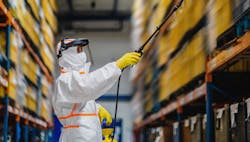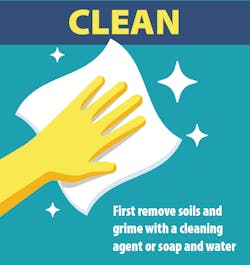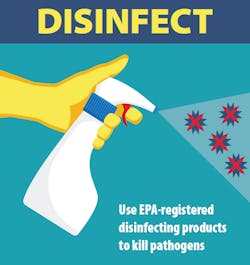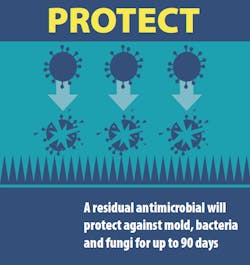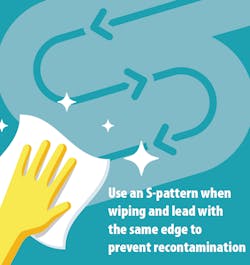Battling COVID-19: Sanitize, disinfect, and sterilize
COVID-19 delivered a wallop to the manufacturing industry. Supply chain disruptions, diminished consumer confidence, and concern for worker safety forced many operations to shut down or dramatically cut back. Manufacturing is currently on the rebound but still lagging behind pre-Coronavirus output; July’s industrial production numbers were 8% below February level, according to industrial production and capacity utilization data from the Federal Reserve.
In the days following the initial pandemic chaos, plant managers and operations directors were faced with serious health and safety issues. One facility manager reported 30 positive COVID-19 tests in the early weeks. Each positive result meant a round of contact tracing and more testing. These led to personnel shortages and production delays, in addition to liability concerns.
New scientific study of the virus over the past few months has provided better infection control protocol and a slowing of the spread. But how do you know who to trust regarding disinfection? “It is essential that your cleaning team follows CDC guidelines,” said Mark Cyganiak, president of ServiceMaster Restore, referring to the Centers for Disease Control and Prevention. “They also must use the recommended products, equipment and techniques. There is a great deal of science involved in infection control and the protocols are strict.”
Cyganiak and other cleaning professionals have fielded dozens of calls in recent months from plant managers with questions about sanitization. Many of the same inquiries come up again and again. The following are some of the most frequently asked questions submitted to cleaning professionals.
How do I know if my facility is safe?
In a facility with many people coming and going, safety can be fleeting. You can be safe from the coronavirus by performing a deep clean of your plant followed by thorough disinfecting using U.S. EPA-registered products on list N. However, once people are reintroduced to the area, there is the chance of reinfection, from COVID-19 or some other pathogen. Maintaining a safe workplace requires regular cleaning and disinfecting, especially if the facility has been exposed to COVID-19.
Infection prevention specialists recognize three levels of clean: sanitized, disinfected, and sterilized. Cleaning begins with the removal of visible soil: the grime, dust, and dirt that come with everyday use.
Sanitization and disinfection describe different levels of biological cleaning. Sanitizing significantly reduces the levels of bacteria found on surfaces and in laundry. Disinfecting kills bacteria at a higher rate and it deactivates viruses (technically, you cannot “kill” a virus since it is not a living organism). Disinfection makes an area generally safe for humans.
Sterilizing is the removal of all microbial life, the highest level of clean attainable and the goal for hospital operating rooms. Achieving a safe working environment in a manufacturing facility requires a two-step approach: thorough cleaning using proper techniques followed by disinfecting with the right products.
If you want verifiable proof your facility is clean, talk to a professional about adenosine triphosphate (ATP) testing. ATP is an enzyme that is present in all organic matter. A luminometer will reveal the presence of ATPs on a surface, indicating its level of disinfection.
Is my cleaning crew qualified for dealing with COVID-19?
Are they carefully following CDC regulations and U.S. EPA specifications? If not, your facility may be at risk for infection. There should be a detailed list of high-touch points throughout the plant that are cleaned multiple times a day. Those responsible for cleaning, whether it is the janitorial staff or line employees, should be familiar with wiping and mopping techniques that won’t re-contaminate a surface. An S pattern is recommended: wiping in one direction with a leading edge, and not back-and-forth, which can spread bacteria rather than remove it. They also must be familiar with product application instructions that specify dwell time, which is the amount of time a disinfecting product must be wet on the surface to kill bacteria and deactivate viruses.
Do foggers and electrostatic sprayers work?
Foggers and electrostatic sprayers are two of the devices used to apply cleaning solution or disinfecting products over a larger area quickly. Pump sprayers and electric sprayers are also used for this purpose.
A fogger vaporizes and sprays antimicrobial or antiviral products in Ultra Low Volume (ULV) droplets. It works well in large areas with mostly flat surfaces. Electrostatic sprayers utilize an electrode in the spray nozzle to create a positive charge that atomizes the disinfecting solution, releasing charged droplets in a mist that are attracted to surfaces. It wraps around the underside of chairs, desks, and equipment, regardless of the direction of the spray. Electrostatic sprayers are considered the fastest, most effective method for disinfecting large spaces with many different surfaces.
How do we clean electronics without damaging them?
Professionals use a four-step process. First, de-energize; turn off the device and disconnect it from electricity. Second, clean with a vacuum fitted with a HEPA filter. HEPA (high-efficiency particulate air) filters capture smaller particles than ordinary filters and reduce dust. Third, blow out any remaining loose debris with compressed air. And fourth, disinfect the surfaces that employees touch. You can wipe down the surfaces with a disinfectant being careful to follow label instructions or use a fogger or electrostatic sprayer. Do not saturate the surface, as too much moisture can cause damage to electronic circuits.
What if we have a positive COVID-19 test?
Anyone who tests positive, as well as those with whom they have had direct contact, should be quarantined. Tape off the area where that person or persons worked and make it off limits until it has been thoroughly cleaned and disinfected. Trace the steps of the infected employee and disinfect those areas, as well, paying special attention to high-touch points.
Cleaning crews responding to a positive COVID test should wear full personal PPE. Ideally, this would include disposable gowns, aprons, or jumpsuits, as well as disposable gloves, eye protection, and a face mask or respirator. If disposable coverings are not available, reusable items must be laundered immediately after use.
All employees must be active in protecting themselves and others from spread of the virus, even more so in the aftermath of a positive exposure. Frequent handwashing, proper coughing and sneezing etiquette, and the use of face masks and disposable gloves are recommended. Limit personal contact as much as possible, and clean common areas like break rooms and restrooms often and thoroughly.
“We are extremely proud of how our company culture has adapted to the new normal of protecting everyone’s health and safety,” said a facility director whose plant was hit hard by Coronavirus. “We have social distancing practices; we are disinfecting after every shift, and we provided PPE to all our employees. They take a lot of pride in the well-being of their fellow employees.”
There are no shortcuts when it comes to protecting against COVID-19. Cleaning and disinfecting diligence, commitment from management and buy-in from employees will help keep everyone protected from further outbreaks.
Peter Duncanson, CMRS, MWR, MSR, MTC, is director of commercial operations for ServiceMaster Restore, working with franchisees nationwide to provide disaster restoration and infection prevention for commercial clients. Contact him at [email protected].
